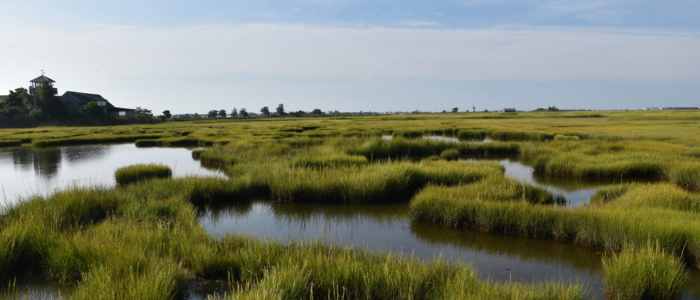
By Alison Mitchell
Executive director, New Jersey Conservation Foundation
For thousands of years, before climate change started accelerating, New Jersey’s coastal marshes slowly regenerated through a harmonious process that deposited sediment from adjoining waters and kept the marshes elevated.
But now, these natural areas are vanishing. Rapidly rising sea levels and erosion are causing marshes to drown, with open water replacing once lush stretches of Spartina grass and shimmering, shallow waterways.
Tidal wetlands are the lifeblood of New Jersey’s coastal ecosystems, breeding grounds for more than 75% of the state’s fisheries species, including crabs and shellfish. The shallow waters are rich in nutrients and home to an abundance of plant and animal species, including rare and endangered plants; amphibians; reptiles; and birds.
Scientists have known for years that marsh loss poses serious risks to both people and natural resources. Marshes absorb storm surge and floodwaters, shelter fish and birds, and store carbon. When they’re submerged, their root systems collapse and shorelines wash away.
Fortunately, a partial solution has emerged: elevating the marsh surface by spreading dredged sediment. Dredging – the practice of excavating mud, sand and sediment from the bottom of waterways to make room for bigger ships or expanded ports – is often cast as a villain in environmental stories, and for good reason. It disrupts ecosystems, stirs up contaminants and destroys sensitive habitats.
But given the lack of alternatives, it doesn’t look like dredging is going away any time soon. Hence the growing push to turn the spoils – the mucky byproduct of dredging – into a tool for restoring and elevating marshes.
Historically, dredged material has been dumped into “confined disposal facilities” or trucked off to be spread in places far from the water. One example is Tuckahoe Turf Farm in the Pine Barrens’ Estell Manor City, where marine dredge spoils have been applied to farmland. The practice makes no sense from an ecological standpoint – the salt content alone is problematic – and it permanently removes what can be valuable sediment from the coastal system.
“We’re watching these marshes collapse in real time,” says Fred Akers, operations manager of the Great Egg Harbor Watershed Association. “We can either keep hauling this dredge material away to landfills or the Pine Barrens or we can use it to rebuild what we’re losing.”
Instead of discarding the dredge spoil, advocates are working with agencies like the New Jersey Department of Environmental Protection (NJDEP) and Department of Transportation (NJDOT) to reuse dredged material for marsh restoration, ideally placing it right back where erosion is taking its toll. It’s neither simple nor inexpensive: It requires engineering, permitting, careful planning and community buy-in.
In 2022, NJDOT dredged 59,000 cubic yards of sediment from Patcong Creek in Great Egg Harbor at a cost of up to $5 million. That material ended up on land at the former B.L. England power plant site in Beesley’s Point, just one of many missed opportunities for marsh restoration.
One promising example of the shift toward keeping dredged material in the marine system can be found at Tuckahoe Island, a piece of state-owned marshland that’s rapidly eroding. Akers and his team flagged the problem to NJDEP’s fish and wildlife team, and when they also identified nearby dredging needs on the Tuckahoe River, things started to click.
NJDOT agreed to fund the project. It was a win-win … or, at least, a better compromise.
This new strategy doesn’t make dredging “green,” but if we’re spending millions to dig up material anyway, why not use it to save the marshes we’re losing? If we let them drown, we all lose.
To learn more about how you can help preserve New Jersey’s natural resources, visit the New Jersey Conservation Foundation at www.njconservation.org or reach out to us at info@njconservation.org.
